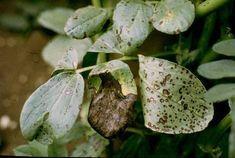

Growers should be gearing up to start their fungicide programme in winter and spring beans, according to chemical supplier BASF.
Chocolate spot (Botrytis cinerea and B. fabae) and rust (Uromyces fabae) can easily escalate to epidemic proportions, when conditions allow. To prevent this happening, says BASF, a programme of effective fungicides will be needed to give the necessary high levels of disease protection, and the company offers growers a choice of three fungicides for beans.
Jonathan Ball, BASF peas and beans product manager: “Fungicide treatments in beans are mainly protectant and so it is important to keep a close eye on disease and be prepared to act quickly. Already a scatter of chocolate spot lesions are being seen on lower leaves and will require the first spray of a two-spray programme, starting at early flowering to prevent the disease spreading up the plant. If the warm weather continues, rusts could become a problem later on in June.
Signum (containing pyraclostrobin and boscalid) has been a technical breakthrough in the protection against chocolate spot and rust. It offers superior performance and greater persistence compared to other protectant fungicides and is the first choice where disease pressure is high for both chocolate spot and rusts,” he said.
“In trials, Signum has given 74 per cent control of chocolate spot, outperforming other treatments. Its high performance is reflected in yields. In a TAG trial, Signum treatments yielded 3.58 t/ha compared with 2.75 t/ha for the untreated, equal to a yield increase of 0.8 t/ha, worth about £150/ha at today’s prices.
“Trials show that Caramba (metconazole) also offers protectant activity against chocolate spot and curative and protectant activity against rust. It is the product of choice for high-risk rust conditions, particularly where early signs of the disease are already apparent. Severe rust infections during flowering and pod fill can cause defoliation and loss of yield. Trials work at PGRO has shown that metconazole gave excellent control of rust in beans. Caramba is a particularly cost-effective treatment,” Ball said.
“The third bean option, Walabi (pyrimethanil + chlorothalonil) is a robust protectant fungicide for winter and spring field beans. It offers preventative treatment against chocolate spot and useful protection against rusts in low to moderate disease situations and should be applied as a preventative treatment before disease becomes established. It provides a strong start to the disease control programme.”
According to BASF advice, when disease pressure is high, even in spring beans, a two-spray programme will be needed in most situations, with the T1 treatments being applied at early flowering and the T2 at mid to late-flowering. Excellent control of chocolate spot and rust has been obtained with Walabi (1.5 l/ha) applied as the early-flowering spray, followed by Signum (0.5 kg/ha) at late flowering. The second spray in this sequence should be modified according to seasonal disease risk. Signum is the preferred choice in high or moderate risk situations due to its robust broad-spectrum activity, whilst a follow-up Walabi application can be used if disease risk remains low to moderate, or is declining, it is advised.
“Chocolate spot is not an easy disease to control and resistance issues need to be considered, which is why it is useful to have a good choice of treatments. With resistance management guidelines in mind, fungicides should be alternated with products from a different cross-resistance group. For example, a programme that starts with Signum at T1 and followed by Caramba at T2 would be a sound approach if the threat from rust increases later in the season,” said Ball.



